Deliciousness permeates a wide range of ethnic neighborhoods in Tortonto, from Little India to Greektown to Chinatown and beyond.
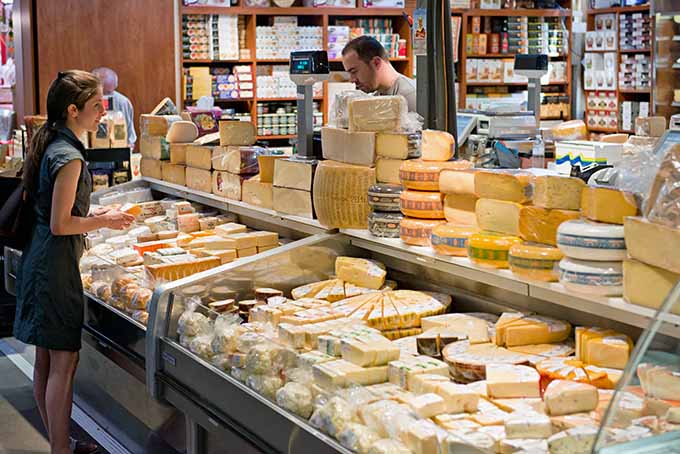
With a population of more than six million people in the Greater Toronto Area, you’ll find the greatest hits of world cuisine in Canada’s biggest city.
The United Nations has recognized it as the most multicultural city in the world, with 51 percent of its residents born outside of Canada. Over 140 languages are spoken there and more than 30 percent of Torontonians speak a language other than English or French, spread over 230 different ethnic origins.
Canadians often joke about their mixed ethnic heritage. We’re a mashup, much like Toronto itself.
In such an eclectic city, dishes are influenced by a variety of cultures and end up with an interesting fusion of flavors, whether it’s kimchi-stuffed empanadas or Turkish donairs with a Berlin street food twist.
The bottom line is that it makes for very interesting eating, and a local cuisine that inspires local chefs like Lora Kirk.

Chef at Ruby Watchco., a popular farm-to-table restaurant, Kirk says, “I feel spoiled. Living in Toronto is inspiring because it exposes me to so many cultures. Wandering around a neighborhood like Chinatown is like being in another country – without ever having to travel. I can indulge any whim I might have about what I might like to eat or to cook. There’s such abundance here.”
Kirk, who has worked in New York and London with top names like Gordon Ramsay, likes to spend her free time exploring new pockets of the city. Along the way, she discovers new ingredients to give her dishes a fresh twist.
“I can still focus on local products, but I can also use things sourced from all over the world,” she says. “That’s what makes cooking here so much fun. It’s a mix of techniques and cultures. It never gets old. In Toronto, I’m constantly learning and growing as a chef.”
The City’s Cultural Mosaic
Toronto’s sheer size does help to shape its food scene. According to culinary historian Shirley Lum, where there is demand, there will be a supply.
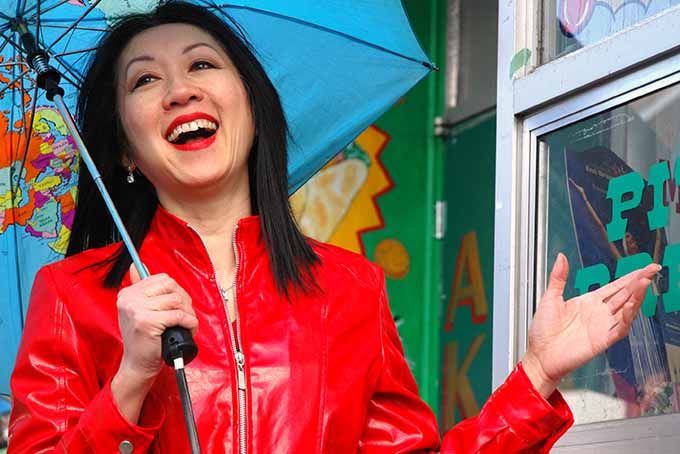
Lum offers food-focused walking tours of some of the city’s most notable neighborhoods through her company, A Taste of the World.
She points to the 1970s as a turning point for the region – a time when prime minister Pierre Trudeau (father of Canada’s current leader, Justin) introduced new immigration policies that made immigration easier and more fair. Toronto saw a sizable wave of new arrivals.
Initially, a great number of new Canadians were from Asia and the Caribbean. Then more came from places like Uganda (after president Idi Amin announced he was expelling residents of Asian decent), Chile (following the overthrow of the government), and Lebanon (during its civil war).
In 1979 and 1980, more than 60,000 refugees arrived from Laos, Vietnam, and Cambodia. Toronto’s Chinatown, once largely made up of Cantonese speakers but now largely Mandarin, welcomed them into the mix.
“It would be more accurate now to call it ‘Asiatown,’” says Lum. “It’s changed so much.
“It helped spark an incredible mix of grocery stores, restaurants, noodle shops and dumpling spots. ‘Toronto’ is a Huron First Nations word that means ‘meeting place.’ It was once a place that brought together many tribes.
“Now, it’s many different cultures. The city is still true to its roots.”
The Many Flavors of Asia
If you tell a local that you’d like to visit Chinatown, they might ask, “Which one?” The city has several.
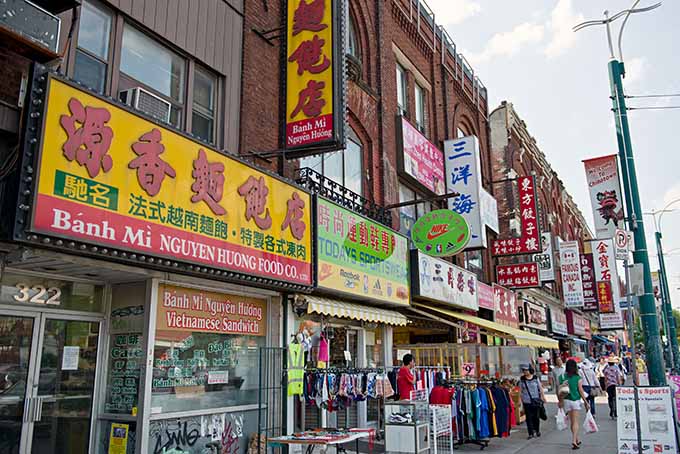
The downtown one, between Queen and College Streets and along Spadina Avenue, has one of the highest concentrations of Chinese people outside of China itself.
Street and even bank signs are written in both English and Chinese. Its aromas, sights, and sounds transport you to cities like Shanghai and Hong Kong – without the jetlag.
Lum points out that the first Chinese restaurant opened in Toronto in 1969, at Spadina and Dundas.
Cantonese
The first residents in the area were Cantonese, arrivals from China’s Guangdong Province – many who came to Canada initially to work on construction of the cross-country railroad.
That was the beginning of a new type of Chinese food, represented by dishes like chop suey.
“It was a mix of whatever leftovers they had at the time,” Lum explains. “And for many Canadians, that was their first exposure to what they thought of as Chinese food.”
Downtown’s Chinatown still features a great number of Cantonese restaurants – ones like King’s Noodle Restaurant. Over the decades, it has changed with the area’s shifting demographic, adding Szechuan and even Thai dishes to its menu.
Dishes here are churned out at a frantic pace, to a dining room that is almost always packed.
Cantonese specialties like barbecued duck and pork hang in the front window, and big vats of soup provide a steamy cloud to welcome you as soon as you walk in the door.
Grab a seat at one of the communal round tables and you’ll likely have dining companions from all over who have come to slurp up giant bowls of soup (like congee and wonton).
The hot and sour soup is often touted as the best in the city by local food bloggers. It blends heat and vinegary flavors beautifully, alongside long ribbons of tofu, bamboo shoots, and shitake mushrooms.
Pair it with yao tiao, a long, salted donut made on-site, perfect for soaking up the last remaining pool of soup at the bottom of your bowl.
Expect sticker shock (in a good way) when you get your bill. You and a dining companion can easily fill up for less than $20 (US).
Dim Sum
If you’re a dim sum fan, Sky Dragon is a Chinatown institution worthy of any stomach space you’re willing to give.
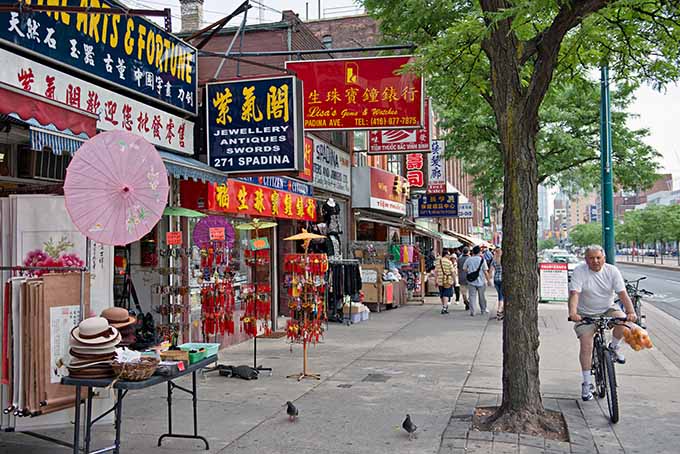
Located on the top floor of Dragon City shopping mall, what it lacks in décor and ambience it makes up with extensive, tasty offerings.
On her walking tours, Lum explains that the first dim sum was served out of bamboo baskets that vendors used to hang around their necks on a string, to sell to people on the street.
Times have changed. Servers at restaurants like Sky Dragon now wheel metal carts through the dining room.
Here, expect to see a parade of dim sum’s greatest hits with steamed pork and shrimp dumplings, fried calamari, sweet and flaky barbecued pork buns, crispy wontons, honey garlic ribs, green onion pancakes, tripe, and chicken feet.
Toronto has other Chinatowns as well. North of the city, Markham has Yang’s Fine Chinese, a local favorite for its fancier version of dim sum that’s served in a more elegant dining room.
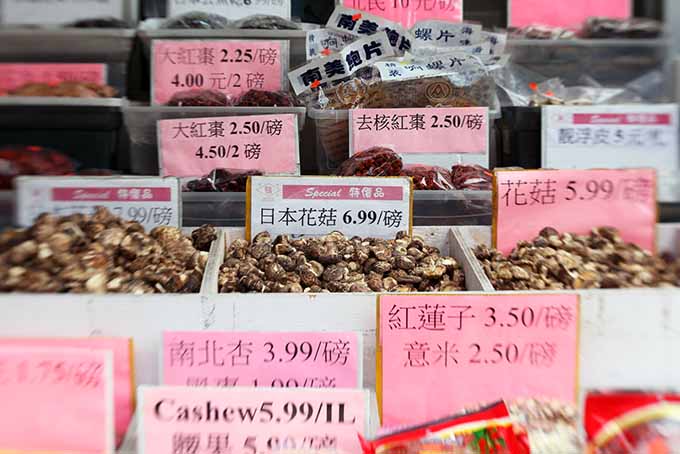
In Richmond Hill, 369 Shanghai Dim Sum shakes up the usual offerings in favor of less common fare such as the fabulous “juicy buns,” wheat dough envelopes filled with stock and meat, or seafood.
Chinese Baked Goods
If you love Chinese pastries, swing by Dingdong Pastries & Café at 321 Spadina Avenue.
Seats are a rarity, so get your fill of steamed pork and veggie buns, red bean rice balls, and gooey butter egg tarts to go.
Seafood
Also beyond the main drag of Chinatown, at the Mississauga Chinese Centre – along with dental offices, insurance agencies and produce stores that serve the local Chinese community – there are restaurants like Blue Lagoon with dishes focused on seafood including Alaskan king crab, geoduck, and lobster.
Korean
Korean cuisine sizzles throughout Toronto.
In Thornhill, Sariwon Korean BBQ draws locals north, even those who rarely venture far from downtown.
They come for the quality cuts of meat here, from pork belly to marinated short ribs, destined for tabletop grills for diners to cook up on their own, or for slow cooking at home.
Koreatown, spread along Bloor near Ossington, has plenty of the usual hot pot restaurants. But it holds some surprises as well.
Tofu Village serves up a wicked version of pajung, seafood pancakes chock full of shrimp, octopus, and scallions. Sesame-oil-slathered chap chae, or potato noodle, is a hearty choice.
Oddseoul is the lovechild of Korean and Asian-American cuisine. Think small plates of bulgogi cheesesteak sliders made with short rib and brisket topped with kimchi hollandaise, or lamb and potato stew with a zingy hit from the house-made chili paste.
Sushi
If sushi is more your speed, there’s Sushi Kaji. Located in Etobicoke, a suburb in the west end, this is the city’s most acclaimed Japanese restaurant.
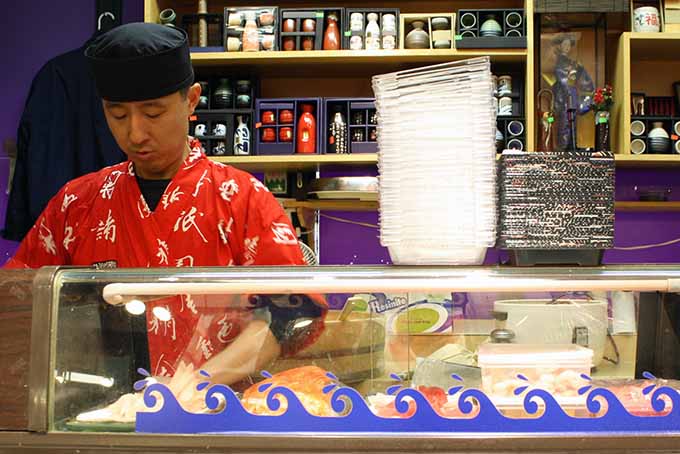
The establishment prides itself on providing the most authentic dining experience possible.
As Lum explains, “Because of the wealth of ingredients in Toronto, people are able to cook authentically. You now see local farms growing Thai eggplant and baby bok choi, and markets bringing in food from all over the world because the population is big enough to make it worthwhile for sellers. And the greater demand made these ingredients affordable and accessible.
“And, when I use the word, ‘authentic’ as a culinary historian, I look at how things were cooked in the past and how they are cooked now. It all ties into what ingredients are available.”
Sushi Kaji is one of the rare restaurants that can claim such authenticity. All of its rice, vegetables, and seafood are flown in from Japan.
Chef Mitsuhiro Kaji is such a stickler for perfection that he insists on making even the soy sauce in house. He boasts that, within 24 hours of a fish coming out of the water near Japan, it’s in his kitchen being prepped.
In his native Japan, he started making sushi at age 13, then spent more than a decade studying under various masters to hone his craft and to learn new techniques. When he came to Canada in 1980, Kaji wasn’t pleased with the quality of sushi he found locally.
He vowed to create something different in his restaurant, honoring the quality of delicate ingredients by not over-handling them. Too much handling affects temperature, which can ruin texture and taste.
This near-fanatical attention to detail constantly wins over diners and food critics.
Spicing Up the Indian Food Scene
Little India may be just a small area tucked to the east of the downtown core, but it is one of the best sources of South Asian goods in North America.

As you walk past the shops along Gerrard Street, Bollywood music comes spilling out the doors and the scent of spices wafts through the air.
Boutiques featuring a glittering array of colorful saris share the block with vendors selling DVDs of the latest Indian blockbuster films, and well-stocked grocery stores. In the summer, street vendors barbecue corn on the cob and rub it with lime wedges and a dash of chili powder.
Buffet-style restaurants, featuring dishes done in a basic home-cooking style, dot the strip every few yards. But there are plenty of alternatives to this version of Indian cooking available.
Vegetarian Street Food
Bombay Chowpatty (1386 Gerrard Street East) takes its inspiration from Mumbai street food served along Chowpatty Beach, and opts to go for a strictly vegetarian menu.
Its veg burger hits all the right notes with a fried potato patty dressed up with chickpeas, red onions, and tomatoes.
Pakistani/Northern Indian
On the more elegant side, Lahore Tikka House taps into the robust spices from Pakistan and Northern India.
Divided geographically by the Partition of India in 1947, here they’ve come together in a diverse menu, reflective of founder Alnoor Sayani’s heritage – a Ugandan immigrant of Pakistani decent who settled in Toronto’s Little India via England.
His menu reflects his journey. Butter chicken (a British creation) has a nice balance of heat and creaminess, courtesy of house-made yogurt. Seekh kebabs, a traditional Pakistani dish that is the house specialty, are made with minced meat and spices, cooked in a tandoor or clay oven.

To cool the lingering heat, dive spoon first into bowls of khoya kulfi, Indian-style ice cream flavored with cardamom and chopped nuts.
Khoya has a smooth, cheese-like texture and it’s used often in Indian sweets (a.k.a. mithai) like barfi. It’s made by heating milk in a pan until the liquid evaporates, leaving the solids behind.
European Delights
Continuing our food tour of the city, let’s move west from Asia to Europe…
Italian
If you’ve ever doubted just how strong the Italian community in Toronto is, swing by the Little Italy, at Dufferin and St. Clair, during the World Cup soccer championships. It’s sheer bedlam.
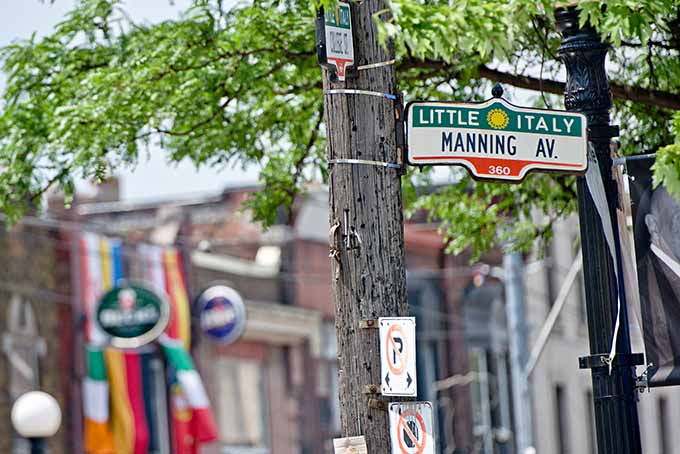
Almost 34 percent of Italian Canadians live in the Greater Toronto Area. This bodes well for finding a bounty of Italian fare.
Start exploring along College Street West, an eclectic combination of cocktail bars and eateries that have been in the neighborhood for decades.
Try the family-run Café Diplomatico, or “The Dip” as locals call it. Opened in 1968, it’s the place to hang with your peeps, drink high-octane cups of espresso on the patio, and eat heaping plates of pasta carbonara.
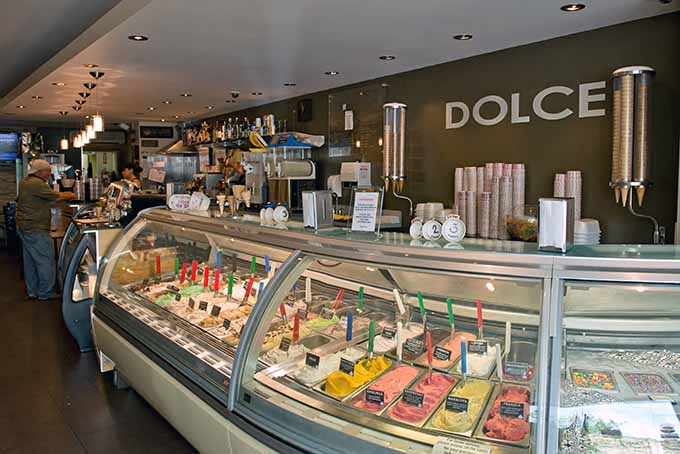
Newer hangouts like Bar Italia are sleeker, slicker, and more about being seen on the scene, though they do have excellent sandwiches with international flair (like the Cubano with roasted pork, avocado, and pancetta).
Some of the most perfectly executed pizza on the strip comes from Pizzeria Libretto, well loved for its wood-fired traditional Neopolitan pies, featuring simple, high-quality ingredients.

The best of Italian fine dining shifts downtown to The Ritz Carlton hotel’s TOCA, a collaboration with German chef Oliver Glowig, one of Rome’s most accomplished culinary talents. In an elegant, dimly lit dining room, dishes are plated artfully and delivered to tables by experienced, knowledgeable wait staff.
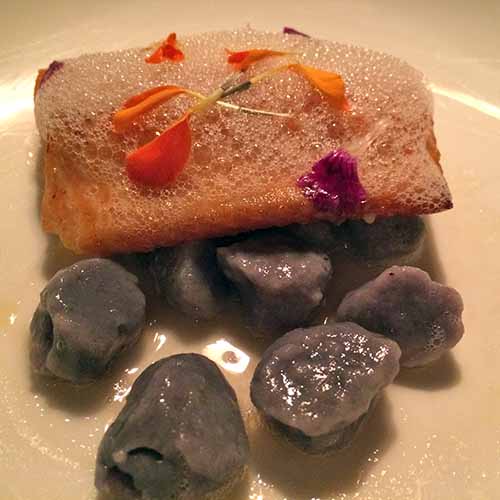
Beloved Italian dishes use traditional techniques for dishes with local ingredients, like purple potatoes for topped with smoked trout, both sourced in Ontario. Glowig’s twist on a caprese salad incorporates Nova Scotia lobster, buffalo mozzarella, and braised tomato.
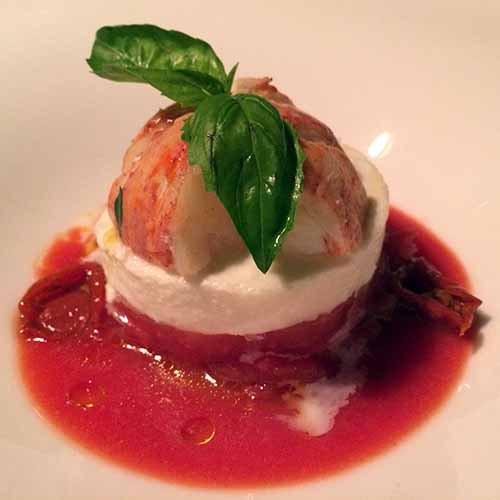
And look no further than the restaurant’s cheese cave for global representation. It was constructed in the middle of the dining room, glass doors revealing the goodness contained within the temperature- and humidity-controlled room.
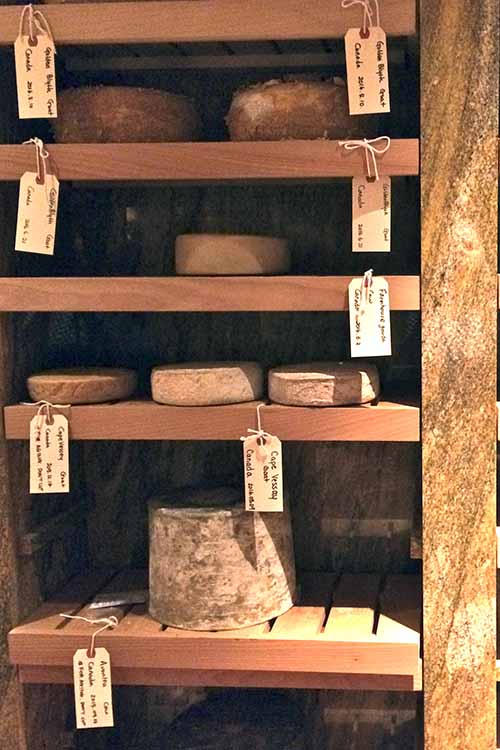
Naturally, there’s a strong showing of Italian cheese, including a massive wheel of Parmigiana-Reggiano worth about $1,400. Other shelves are stocked with celebrated Canadian and Spanish varieties, such as Lankaaster from Ontario, winner of Best Cheese in the World honor at the 2013 Annual Global Cheese Awards in England.
Greek
Rivaling the strength of the Italian food scene is the one devoted to Greek cuisine. Stretched along the Danforth, Greektown puts all the best things to eat in one intriguing neighborhood.

Of course, there are oodles of gyro and souvlaki joints like Messini or Square Boy Drive-in, but this is an area where you really want to soak up the ambiance, especially on a patio come summer.
The popular Mezes has a lively atmosphere. Whether you eat in the two-level dining room or on the small sidewalk patio, be sure to load up your table with plates of grilled calamari, lamb chops, carafes of Greek wine, and house-made baklava for dessert.

Global Mashups at the Market
The 200-year-old St. Lawrence Market attracts locals and tourists alike with more than 120 vendors spread out over two floors. In 2012, National Geographic’s book Food Journeys of a Lifetime ranked it number one on its top ten list of the best food markets of the world.
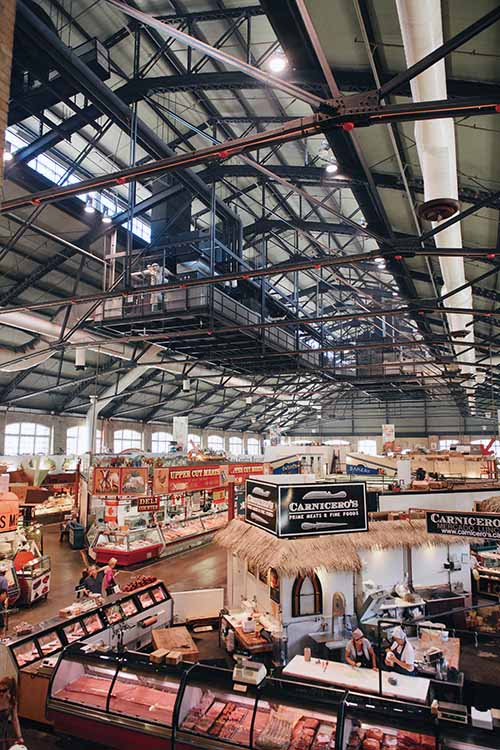
The South Market is packed with unique vendors, like Rube’s Rice with an international selection of rice and lentils, Caviar Direct, known for artisanal smoked salmon and caviar, and Second Wind, which sells elk meat, a diet staple for some of Canada’s First Nation people.
The smaller North Market across the street is open only on Saturdays, selling produce, meat, and baked goods. On Sundays, it serves as a popular antique market.
Top globally inspired highlights include:
Portuguese Tarts
Creamy, eggy, crunchy Portuguese custard tarts from Churrasco’s.
Montreal-Style Jewish Bagels
Sesame bagels baked on-site in a wood-fired oven at St. Urbain, inspired by those produced by Montreal’s most famous Jewish bagel makers.
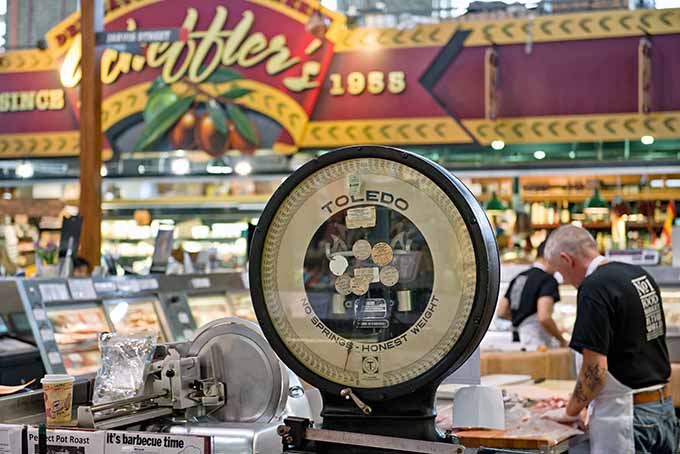
Pierogies
Potato and cheese pierogi topped with sour cream from European Delight.
Italian Veal Sandwiches
A veal sandwich slathered in sweet or hot roasted peppers, eggplant slices, and a traditional Italian-style tomato sauce from Uno Mustachio.
Canadian Peameal Bacon
If you’re able to try just one a uniquely Canadian specialty, make it the famous peameal bacon on a bun cooked up on-site at Carousel Bakery.
Salty slices of back bacon are coated these days with cornmeal – ground yellow peas were used in the past, which inspired the name “peameal.”
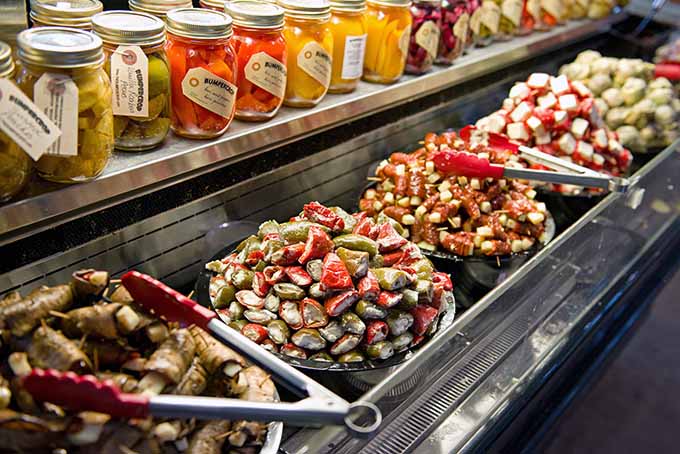
These are grilled and piled on a puffy white roll. Add a squirt of spicy mustard, and bliss is within reach.
If you’re short on time, consider a guided food tour through the market. The Culinary Adventure Co. offers a smartly curated visit that hits many of the market’s highlights in just 2.5 hours.
In the heart of downtown, Kensington Market has a colorful history. It was once populated primarily Eastern European Jews early in the twentieth century.
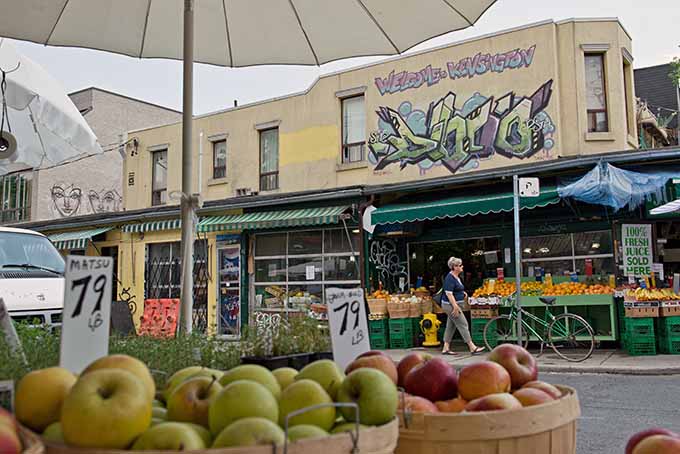
The densely packed neighborhood was set to meet the wrecking ball in the 1960s to make way for apartment buildings. Thankfully, the newly elected mayor nixed those plans.
In 2006, it was designated a National Historic Site in 2006, ensuring its long-term survival.
Come hungry and sample:
Jerk Chicken
Spicy jerk chicken, swimming in homemade sauce, at Rasta Pasta.
Chilean Empanadas
Chilean-style beer, chicken, or veggie empanadas from Jumbo Empanadas.
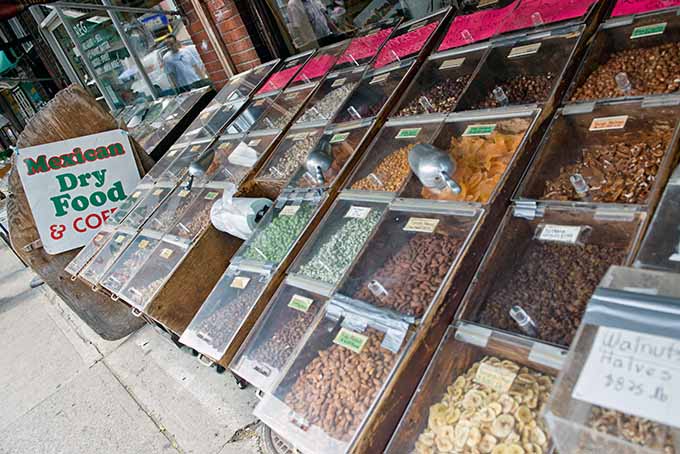
Fish Tacos
Baja fish tacos from Seven Lives, made with crispy batter-dipped and fried fish.
Berlin Street Food
Otto’s Berlin Döner, serving Berlin street food favorites – like döner kebabs and currywurst, pork sausage served with curry ketchup.
Hungarian and Thai
Hungarian Thai Bar & Eatery, an odd yet wonderful convergence where you may order Hungarian or Thai cuisine from the extensive menu, from schnitzel to a bowl of noodles covered in a coconut and lemongrass-infused sauce.
A Truly Global Experience, All in One City
The international offerings in Toronto are so vast that this post only begins to scratch the surface. It truly is like traveling the world in a single city.
When you visit, follow chef Lora Kirk’s lead and wander through its neighborhoods – more than 60 distinct areas in total – nibbling and making new discoveries all the way.
Or consider one of the many food tours offered that focus on specific neighborhoods, such as Chinatown or Kensington Market. It’s sure to be a delicious journey!
Do you have a favorite spot or neighborhood where you like to eat when you visit Toronto? Share your suggestions in the comments below!
Photos by Michele Sponagle where credited, © Ask the Experts, LLC. ALL RIGHTS RESERVED. Other photos sourced from Toronto Tourism Department where credited. See our TOS for more details.
About Michele Sponagle
Based near Toronto, Ontario in the small town of Paris, Michele Sponagle specializes in lifestyle subjects, especially food, travel, and health. She has written three books and contributes to many top media outlets. Her adventurous slants on food and culture have taken her to 70 countries and still counting. She has fished for king crabs in the freezing waters off the coast of Norway, and foraged for chanterelle mushrooms in the forests of Oregon. Her proudest accomplishment to date is learning to like eggs.




This is great! You can get a bagel for breakfast at one place, go across town and stuff yourself on chana masala, then go to another place to get a snack of baklava, then go out for a nice Italian dinner. When I lived in Michigan, I had no idea that this was right across the border. I knew there were a lot of people of Caribbean and Chinese origin in Toronto, but I never knew the city, and it’s culinary life, were so diverse! I know there is only so much space in an article, but does anyone have any recommendations for good Caribbean food places in Toronto?
That sounds like a great way to really expose yourself to all sorts of different foods from around the world. It really makes me wish that I lived somewhere a little more cultured and diverse, but I guess you get what you are given and you go from there. Maybe a trip to Canada should be in the works.
Thanks for this helpful info. I’m making a plan to go tour to your city as I feel so bored in this lockdown.
However, I am a foodie and love to taste Thai foods and recipes. But I was confused on which restaurant I should go to when I visit Toronto.
Thankfully, now I have a handful of options. Thanks for sharing this in-depth info.
One question- is there any restriction to visit your country due to Covid-19? Are the restaurants open?
Waiting for your response…
I was able to do some research for you, Jennifer. Toronto is in Stage 3 of their operation procedures for restaurants and other businesses- many restaurants have been able to reopen with social distancing regulations and mask wearing in place, and making reservations in advance is recommended, as is outdoor dining.
As for travel restrictions, this depends in part on where you are coming from – there are border restrictions for discretionary travel in place. Healthy travelers entering Canada must follow the rules of their national Quarantine Act, and visitors must quarantine for 14 days after arrival.
I remember the time like yesterday when I came to Toronto from India and wanted to try different cuisines, restaurants, and all types of food possible. Your list helped me a lot to try various things. Thank you for that.